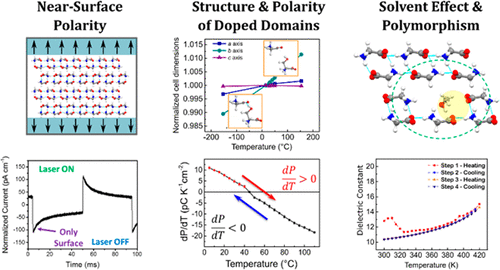当前位置:
X-MOL 学术
›
Acc. Chem. Res.
›
论文详情
Our official English website, www.x-mol.net, welcomes your
feedback! (Note: you will need to create a separate account there.)
Polar Imperfections in Amino Acid Crystals: Design, Structure, and Emerging Functionalities
Accounts of Chemical Research ( IF 16.4 ) Pub Date : 2018-04-20 00:00:00 , DOI: 10.1021/acs.accounts.8b00054 Elena Meirzadeh 1 , Isabelle Weissbuch 1 , David Ehre 1 , Meir Lahav 1 , Igor Lubomirsky 1
Accounts of Chemical Research ( IF 16.4 ) Pub Date : 2018-04-20 00:00:00 , DOI: 10.1021/acs.accounts.8b00054 Elena Meirzadeh 1 , Isabelle Weissbuch 1 , David Ehre 1 , Meir Lahav 1 , Igor Lubomirsky 1
Affiliation

|
Crystals are physical arrays delineated by polar surfaces and often contain imperfections of a polar nature. Understanding the structure of such defects on the molecular level is of topical importance since they strongly affect the macroscopic properties of materials. Moreover, polar imperfections in crystals can be created intentionally and specifically designed by doping nonpolar crystals with “tailor-made” additives as dopants, since their incorporation generally takes place in a polar mode. Insertion of dopants also induces a polar deformation of neighboring host molecules, resulting in the creation of polar domains within the crystals. The contribution of the distorted host molecules to the polarity of such domains should be substantial, particularly in crystals composed of molecules with large dipole moments, such as the zwitterionic amino acids, which possess dipole moments as high as ∼14 D. Polar materials are pyroelectric, i.e., they generate surface charge as a result of temperature change. With the application of recent very sensitive instruments for measuring electric currents, coupled with theoretical computations, it has become possible to determine the structure of polar imperfections, including surfaces, at a molecular level. The detection of pyroelectricity requires attachment of electrodes, which might induce various artifacts and modify the surface of the crystal. Therefore, a new method for contactless pyroelectric measurement using X-ray photoelectron spectroscopy was developed and compared to the traditional periodic temperature change technique. Here we describe the molecular-level determination of the structure of imperfections of different natures in molecular crystals and how they affect the macroscopic properties of the crystals, with the following specific examples: (i) Experimental support for the nonclassical crystal growth mechanism as provided by the detection of pyroelectricity from near-surface solvated polar layers present at different faces of nonpolar amino acid crystals. (ii) Enantiomeric disorder in dl-alanine crystals disclosed by detection of anomalously strong pyroelectricity along their nonpolar directions. The presence of such disorder, which is not revealed by accurate diffraction techniques, explains the riddle of their needlelike morphology. (iii) The design of mixed polar crystals of l-asparagine·H2O/l-aspartic acid with controlled degrees of polarity, as determined by pyroelectricity and X-ray diffraction, and their use in mechanistic studies of electrofreezing of supercooled water. (iv) Pyroelectricity coupled with dispersion-corrected density functional theory calculations and molecular dynamics simulations as an analytical method for the molecular-level determination of the structure of polar domains created by doping of α-glycine crystals with different l-amino acids at concentrations below 0.5%. (v) Selective insertion of minute amounts of alcohols within the bulk of α-glycine crystals, elucidating their role as inducers of the metastable β-glycine polymorph. In conclusion, the various examples demonstrate that although these imperfections are present in minute amounts, they can be detected by the sensitive pyroelectric measurement, and by combining them with theoretical computations one can elucidate their diverse emerging functionalities.
中文翻译:

氨基酸晶体中的极性缺陷:设计,结构和新兴功能
晶体是由极性表面划定的物理阵列,通常包含极性性质的缺陷。在分子水平上理解此类缺陷的结构非常重要,因为它们会严重影响材料的宏观性能。此外,可以通过在非极性晶体中掺入“量身定制的”添加剂作为掺杂剂,有意地和专门地设计晶体中的极性缺陷,因为它们的掺入通常以极性模式进行。掺杂剂的插入还引起相邻主体分子的极性变形,从而在晶体内产生极性域。扭曲的主体分子对这些畴的极性的贡献应该很大,特别是在由具有大偶极矩的分子组成的晶体中,例如两性离子氨基酸,其偶极矩高达〜14D。极性材料是热释电的,即,它们由于温度变化而产生表面电荷。随着最近用于测量电流的非常敏感的仪器的应用,再加上理论计算,已经可以在分子水平上确定极性缺陷的结构,包括表面。热电的检测需要连接电极,这可能会引起各种伪影并改变晶体表面。因此,开发了一种使用X射线光电子能谱法进行非接触式热释电测量的新方法,并将其与传统的周期性温度变化技术进行了比较。在此,我们通过以下具体示例描述分子水平上分子性质不同的缺陷的结构以及它们如何影响晶体的宏观特性的分子水平确定:(i)由以下方面提供的对非经典晶体生长机制的实验支持:从存在于非极性氨基酸晶体不同面上的近表面溶剂化极性层检测热电。(ii)对映体疾病通过检测沿其非极性方向异常强的热电而公开的d1-丙氨酸晶体。此类疾病的存在(通过精确的衍射技术无法发现)解释了它们的针状形态之谜。(iii)l-天冬酰胺·H 2 O / l的混合极性晶体的设计-通过热电和X射线衍射测定的可控制极性的天冬氨酸及其在过冷水电冻结机理研究中的用途。(iv)热电学结合色散校正的密度泛函理论计算和分子动力学模拟,作为分子水平确定由掺杂不同l的α-甘氨酸晶体产生的极性域结构的分析方法-浓度低于0.5%的氨基酸。(v)在大量的α-甘氨酸晶体中选择性插入少量醇,阐明它们作为亚稳态β-甘氨酸多晶型物诱导剂的作用。总而言之,各种示例表明,尽管这些缺陷的存在量很小,但可以通过灵敏的热电测量来检测它们,并将其与理论计算相结合,可以阐明它们的各种新兴功能。
更新日期:2018-04-20
中文翻译:

氨基酸晶体中的极性缺陷:设计,结构和新兴功能
晶体是由极性表面划定的物理阵列,通常包含极性性质的缺陷。在分子水平上理解此类缺陷的结构非常重要,因为它们会严重影响材料的宏观性能。此外,可以通过在非极性晶体中掺入“量身定制的”添加剂作为掺杂剂,有意地和专门地设计晶体中的极性缺陷,因为它们的掺入通常以极性模式进行。掺杂剂的插入还引起相邻主体分子的极性变形,从而在晶体内产生极性域。扭曲的主体分子对这些畴的极性的贡献应该很大,特别是在由具有大偶极矩的分子组成的晶体中,例如两性离子氨基酸,其偶极矩高达〜14D。极性材料是热释电的,即,它们由于温度变化而产生表面电荷。随着最近用于测量电流的非常敏感的仪器的应用,再加上理论计算,已经可以在分子水平上确定极性缺陷的结构,包括表面。热电的检测需要连接电极,这可能会引起各种伪影并改变晶体表面。因此,开发了一种使用X射线光电子能谱法进行非接触式热释电测量的新方法,并将其与传统的周期性温度变化技术进行了比较。在此,我们通过以下具体示例描述分子水平上分子性质不同的缺陷的结构以及它们如何影响晶体的宏观特性的分子水平确定:(i)由以下方面提供的对非经典晶体生长机制的实验支持:从存在于非极性氨基酸晶体不同面上的近表面溶剂化极性层检测热电。(ii)对映体疾病通过检测沿其非极性方向异常强的热电而公开的d1-丙氨酸晶体。此类疾病的存在(通过精确的衍射技术无法发现)解释了它们的针状形态之谜。(iii)l-天冬酰胺·H 2 O / l的混合极性晶体的设计-通过热电和X射线衍射测定的可控制极性的天冬氨酸及其在过冷水电冻结机理研究中的用途。(iv)热电学结合色散校正的密度泛函理论计算和分子动力学模拟,作为分子水平确定由掺杂不同l的α-甘氨酸晶体产生的极性域结构的分析方法-浓度低于0.5%的氨基酸。(v)在大量的α-甘氨酸晶体中选择性插入少量醇,阐明它们作为亚稳态β-甘氨酸多晶型物诱导剂的作用。总而言之,各种示例表明,尽管这些缺陷的存在量很小,但可以通过灵敏的热电测量来检测它们,并将其与理论计算相结合,可以阐明它们的各种新兴功能。











































 京公网安备 11010802027423号
京公网安备 11010802027423号